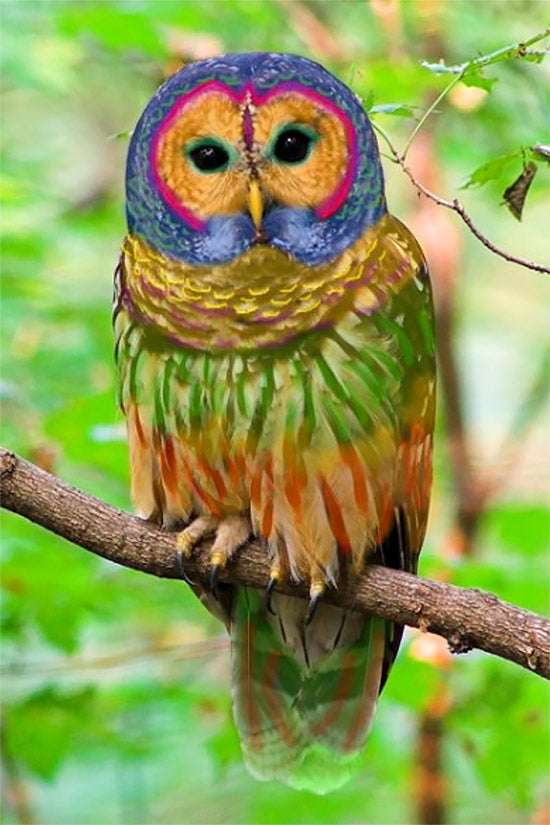Last week, a friend tagged me in a post about a weird bird. I’m used to it—as a known bird guy, friends are constantly making me aware when some new study comes out or a rare bird shows up. But this post was different.
From a Facebook page called “Route 370—Newfoundland News & Weather,” the post had what appeared to be a photo of a red-and-white bird perched on a snowy branch. The text read: “A rare Red and White cardinal in it’s festive colors makes an appearance in Canada. It’s unusual look is caused by Gynandromorphy.”
I’ve seen northern cardinals with gynandromorphism (meaning that an individual exhibits characteristics of both sexes), and they don’t have any of the same colors as the Facebook “Santa cardinal” bird. It also had a thin, yellow bill like a chicken instead of the thick, orange bill of our northern cardinal—a trait that gynandromorphism wouldn’t alter. This wasn’t a cardinal, clearly, but what was it?
Reverse image search was no help, but when I looked closer, the answer was obvious. The bird appeared to have three feet, and the end of its tail was somehow covered in snow. This wasn’t a real photo at all—it was a photorealistic fantasy created by A.I. Ugh.
I posted a quick response to my friend, taking care not to make him feel bad for falling for the hoax, but scrolling down through the more than 2,000 comments, I could see he was hardly alone. With more than 10,000 shares and 24,000 likes, this imaginary bird was a viral hit for a group used to more modest numbers for posts like Garfield saying “Happy Monday!” or warnings about moose on the highway.
Bird photos have always been popular on social media. Birds are beautiful, and they’re beautiful in an uncomplicated way that’s attractive to people who aren’t looking for controversy or politics. Bird photography is an egalitarian pursuit, rewarding equally an image of a rare bird from a remote jungle and a nice picture of a backyard bird on a feeder.


But the popularity of birds on social media, not surprisingly, has led to bad behavior. Photographers bait owls into action shots by tossing them store-bought mice or trim away branches surrounding a nest to get a clearer shot. Those who don’t want to go outside to get bird content have turned to Photoshop and other editing tools (this image of a “rainbow owl” has been circulating online for more than a decade) or taking photos of stuffed animals and passing them off as real.
Generative A.I. has made the process of generating bird content even easier—and even worse. As far as I can tell, the “Santa bird” post originated in late November in another group, Wildlife Planet, that posts nothing but A.I.–generated birds. This group and countless others—most with generic names like Amazing Birds of the World or Beautiful Birds—exist purely to churn fake content onto the screens of an eager and unsuspecting public.
There’s a question about whether this is harmful. A flood of fake bird images is certainly going to make the internet more confusing, and many users lack the ability to tell which birds are real and which aren’t. Bill Hubick, co-founder of the Maryland Biodiversity Project, was alerted last week that his organization had been used as a source for an article called “What Are the Unique Wildlife Species in Maryland?” The entire “article” was generated with A.I. and riddled with errors but also appeared accurate enough to fool someone who didn’t know, for example, that the Maryland darter, which “adds a splash of color to the state’s aquatic ecosystems,” hasn’t been seen since 1988. (Though if you weren’t tipped off by the text, the flying deer and snake-headed bird in the header image might have clued you in.)
Thankfully, there are tools to fight back for the truth. Online services can help spot deepfake videos, and there are A.I. voice detectors. A birder’s best tool might be the Cornell Lab of Ornithology’s Macaulay Library, an online media database of tens of thousands of wildlife species, including birds, amphibians, and mammals. There are more than 10,000 bird species alive on earth, and every single one we know of has an entry in the Macaulay Library. Scrolling through the best of the images makes me frustrated we even bother with A.I. at all. What’s the point of making things up when there are so many stunning real-life birds out there already?
Future Tense is a partnership of Slate, New America, and Arizona State University that examines emerging technologies, public policy, and society.
"bird" - Google News
December 29, 2023
https://ift.tt/RPr3mQY
A.I. came for our jobs, our art, and our souls. Now it's coming for our birds. - Slate
"bird" - Google News
https://ift.tt/X01HmEY
https://ift.tt/E6HsPtw
Bagikan Berita Ini














0 Response to "A.I. came for our jobs, our art, and our souls. Now it's coming for our birds. - Slate"
Post a Comment